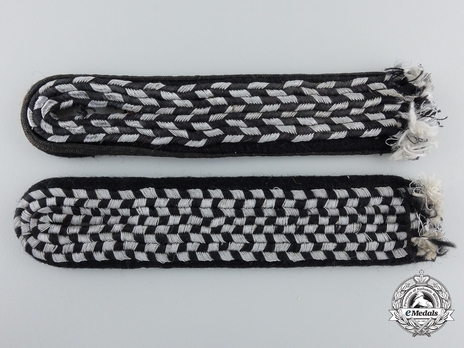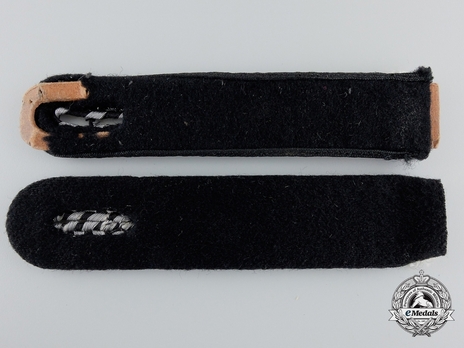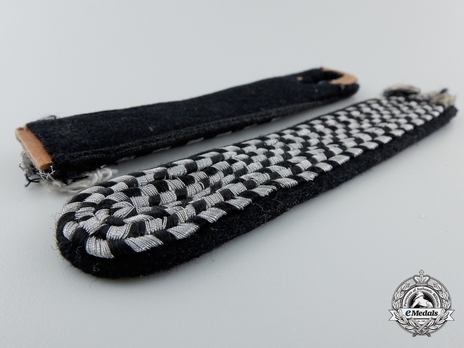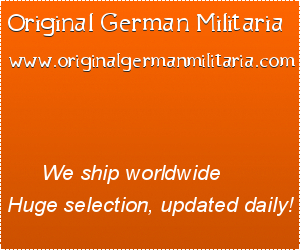NSKK Obertruppführer - NSKK-Mann Shoulder Boards
SKU: 53.GOR.03.02.01.006
Estimated market value:



Estimated market value:
Attributes
History
The NSKK (Nationalsozialistisches Kraftfahr-Korps = National Socialist Motor Corps) was a paramilitary organisation affiliated with the NSDAP, specialising in anything related to the driving of motorised vehicles. NSDAP officials recognised the need for access to cars and trucks for both transportation and propaganda purposes as early as 1922, and certain steps were taken to ensure this need was met. However, it took until April of 1930 for a specialised motor organisation to be officially founded. This organisation was named NSAK (Nationalsozialistisches Automobil-Korps = National Socialist Automobile Corps), but was renamed to NSKK less than 13 months later.
Initially, the NSAK/NSKK was under the control of the SA and existed next to its parent organisation’s own driving-related sub-organisation, the Motor-SA. This changed after the “Night of the Long Knives”, in which many SA leaders were purged and the organisation was substantially disempowered. After July of 1934, the NSKK became an independent organisation whose leader, NSKK-Korpsführer Adolf Hühnlein, answered directly to Adolf Hitler.
The main tasks of the NSKK were to provide transportation for all organisations of the Third Reich, to train and instruct boys and men (and a number of women) in mechanics and driving, and to assist police in regulating traffic. During the mid 1930s, the organisation also provided roadside assistance.
With the onset of the war, the NSKK’s tasks underwent certain changes. Instructing both civilians and soldiers in the driving and maintenance of armored vehicles became a higher priority. The NSKK also began working closely with other organisations, for example Organisation Todt (OT), by providing transportation of workers and supplies for the colossal building project that was the fortification of Germany’s Western border, the Siegfried Line (or Westwall). During the war, the NSKK provided much of the transportation needs for the German Army and the Luftwaffe, including the transport of troops, weapons and ammunition, and building materials, for example for the construction of air bases in the newly conquered territories in Eastern Europe after the attack on Soviet Russia in the summer of 1941.
Parts of the NSKK would come under the control of architect Albert Speer who took over OT after the death of Fritz Todt in 1942, leading to the creation of Transport Brigade Speer (later Transport Corps Speer), which would eventually completely sever its ties to the NSKK.
NSKK shoulders boards were not used to denote the wearer’s specific rank, but rather their rank grouping. Generally, members of the NSKK wore a single shoulder board on the right side, but those who served with the armed forces were required to wear shoulder boards on both shoulders.
The shoulder boards have a black underlay and feature different patterns of cord to denote rank grouping. The edges of the shoulder boards are piped with coloured cord to identify the wearer’s region. The colours are based on the SA regional colours. For more information, consult the SA rank collar tabs section. An exception were senior NSKK leaders who wore shoulder boards piped with carmine cord.
The shoulder board buttons were made of matte white metal, except for members of NSKK motorboat units, who used gilt buttons. They may feature an embossed Arabic numeral to identify the wearer’s group number, either “1”, “2”, or “3”.
The only rank grouping to feature rank signifiers other than cord on their shoulder boards was the most senior rank of Korpsführer. The Korpsführer shoulder boards feature a metal cypher in the shape of three oak leaves on a single stem with two acorns.
The Korpsführer shoulder boards feature a braid of silver cord and the aforementioned metal cypher.
The ranks of Obergruppenführer down to Brigadeführer wore shoulder boards featuring a braid of cord made up of two aluminum cords with a gold cord in the centre.
The Oberführer shoulder boards feature a braid of two gold and two aluminium cords.
The ranks of Standartenführer down to Staffelführer used shoulder boards featuring a braid of intertwined aluminium cord.
The ranks of Sturmhauptführer down to Sturmführer used shoulder boards featuring two parallel rows of double-laid aluminium cords forming a U-shape.
The ranks of Obertruppführer down to NSKK-Mann used shoulder boards with a black/white checker-board pattern.


Comments
Sign in to comment and reply.


Scroll Top